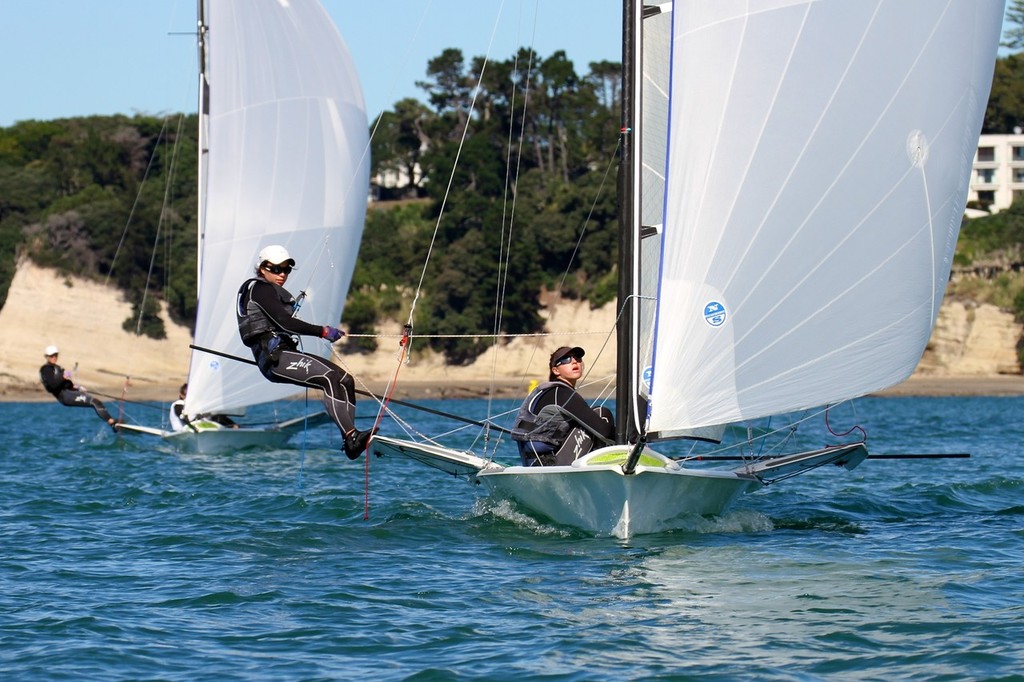FX Rig Designer explains the working of the Fathead Rig + Video
by Richard Gladwell on 1 May 2012

The versatile FX Fathead rig allows the boat to be powered up for light winds and flattened out at the top end of the wind range. Richard Gladwell
www.photosport.co.nz
Mackay Boats John Clinton explains how the Fathead Rig works using video taken from a test sailing session in the FX undertaken on Auckland Harbour on Saturday, when winds gusted to a recorded 31 kts.
Fathead rigs had their origins in 12 and 18ft skiffs, and are so-called because of their large square head in the mainsail.
They have been adopted into a variety of classes, right up to America's Cup level, because of their ability to carry extra area high up in the rig to give power in light and moderate winds, but allow the rig to depower itself in the bigger breezes as the head twists open.
Although the concept is simple, the sail and rig engineering is not. Getting the sail design to work with the spar package is critical, as is the need to reduce sheet loads on the crew.
Clinton has 30 years experience in sail and rig design, having worked as a sail designer for North Sails, and also for for Southern Spars, specialising in dinghy and skiff rigs in both situations. He's also one of New Zealand's top technical sailing coaches.
In these long, unedited video sequences, John Clinton talks us through the essentials of the FX rig using video from ahead of the boat, side on and astern.
Then in a long downwind sequence, he explains how high speeds are achieved in skiffs like the FX using a combination of rig and sail shape to make the boat sail faster, while remaining in easy control.
As Clinton notes several times in the video, the FX has a mast that is one metre shorter than the 49er, however modern sail and rig design allow the designers to optimise the boat to a crew weight - which in the case of the FX is around 120kg. (Interestingly the maximum weight for lightweight women rowers is only 58kg each - so the FX is optimised for crew only 2kg above the womens lightweight rowing weight).
The outcomes are that sailors can power up the rig in light winds, start flattening it using a downhaul - in a similar way to that used on windsurfer rigs, and then in the top end of the breeze the main is flattened, or depowered. The power in the jib is controlled by the sheet position - which was the purpose of the weekend's test in these quite extreme conditions. Also a lot of the rig power is adjusted through the range by changing the stay tensions. The uppers are loosened as the wind increases to allow the top of the mast to fall off sideways to depower the head.
The precision of the rig optimistion for a target crew weight, was demonstrated in on the water testing, involving a heavier, 135kg, very competent male skiff crew against the 123kg female crew in 20kt and 25kt winds, sailing two FX's. The test showed that the heavier male crew had an advantage around the above 25kts and the 123kg crew below 20 kts. 'But the differences around the course between the crews in these wind strengths was small', said Clinton. 'My guess is that the cross-over was around 22kts.'
Capsizing a skiff is covered at the end of the video.
Up and downwind capsize situations are covered, again with unedited video sequences, showing how quickly a skiff like the FX can be righted in about 90 seconds, in 25 knots of wind - even with spinnaker set, and when one or both crew have fallen off the boat.
The keys to the quick recovery are the FX's lower rig height and lighter rig weight, and having the skipper and crew correctly positioned. Swimming the boat into a position where the wind can help with the righting operation does help, but is not essential. Just like the 49er, in extreme situations (not seen in the video) the crew holds onto the centreboard in a move known as the Russian or Eskimo Roll, and effectively becomes a bulb keel, preventing the boat from capsizing a second time.
The handing on of sailing tips involving launching, capsizing, and boat handling from the Mens 49er crews has accelerated the progress of Womens crews transitioning into the FX. In both classes, and indeed all skiff classes, correct and precise technique is vitally important to sailing this type of boat to its best. Taking just 90 seconds to right the FX is testimony to the benefits of this sharing of experience.
The performance of the FX rig is expected to lead to the development of a significant 'Weekend Warrior' market as a variety of skiff sailors take to the class, using second hand 49er hulls and dropping the FX rig onto the boat, for a very modest outlay. Currently Mackay Boats already have orders for five FX rigs from Weekend Warrior crews.
If you want to link to this article then please use this URL: www.sail-world.com/96707